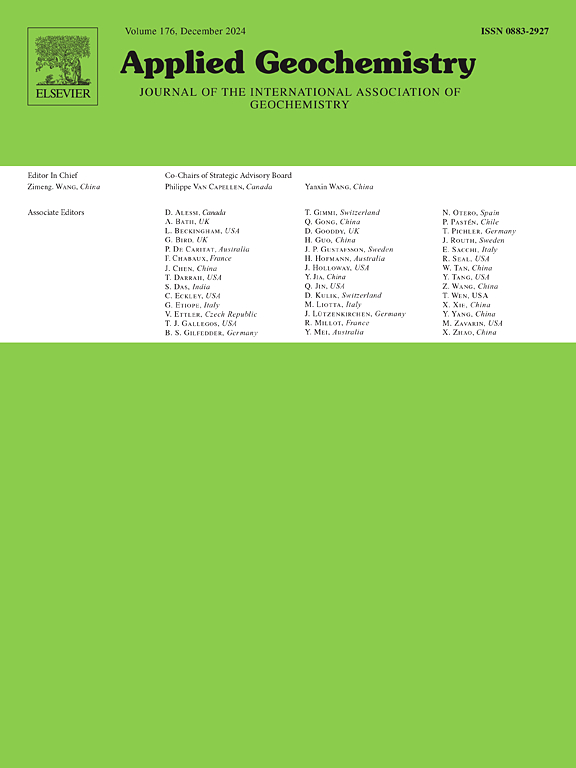Tracing organic matter sources in upland lakes of southeastern Amazonia: Insights from a Bayesian mixing model
IF 3.4
3区 地球科学
Q1 GEOCHEMISTRY & GEOPHYSICS
引用次数: 0
Abstract
This study investigates organic matter (OM) sources in upland lakes within the Carajás and Araguaia regions, in the southeastern Amazonia. Focusing on lakes developed on lateritic crusts, the research encompasses different types of lake basins to better understand variations in OM sources, using a Bayesian mixing model (MixSIAR), based on a dataset of carbon isotopes (δ13C) and C:N ratio from sediment cores. Our results underscore the influence of local vegetation and lake basin evolution on OM composition, revealing some similarities between the two regions. For instance, in the Carajás region, active lakes (AM, LV2, LTI, and LSL) exhibit higher proportions of OM sourced from C3 plants, macrophytes, and soils compared to filled lakes (R5, ST02, LB3, LB4, and LTM). While, filled lakes in the Araguaia region demonstrate greater contributions of OM from C3 plants, phytoplankton, and soils. The Bayesian mixing model effectively estimates OM contributions and tracks historical changes in sediment profiles, offering a robust framework for similar studies in tropical lake ecosystems. Overall, this research enhances our understanding of OM dynamics in tropical upland lakes and lays the groundwork for future investigations into environmental change and management strategies in these distinct regions of the Amazon ecosystem.
追踪亚马逊东南部高地湖泊的有机质来源:贝叶斯混合模型的启示
本研究调查了亚马逊东南部Carajás和阿拉瓜亚地区的高地湖泊中的有机物(OM)来源。该研究以红土地壳上发育的湖泊为重点,采用贝叶斯混合模型(MixSIAR),基于沉积物岩心的碳同位素(δ13C)和C:N比数据集,涵盖了不同类型的湖盆,以更好地了解OM来源的变化。我们的研究结果强调了当地植被和湖盆演变对OM组成的影响,揭示了两个地区之间的一些相似性。例如,在Carajás区域,活性湖泊(AM、LV2、LTI和LSL)与填充湖泊(R5、ST02、LB3、LB4和LTM)相比,显示出来自C3植物、大型植物和土壤的OM的比例更高。而在阿拉瓜亚地区充满水的湖泊中,C3植物、浮游植物和土壤对有机质的贡献更大。贝叶斯混合模型有效地估计了OM的贡献,并跟踪了沉积物剖面的历史变化,为热带湖泊生态系统的类似研究提供了一个强大的框架。总的来说,这项研究增强了我们对热带高原湖泊OM动态的理解,并为未来研究亚马逊生态系统这些不同区域的环境变化和管理策略奠定了基础。
本文章由计算机程序翻译,如有差异,请以英文原文为准。
求助全文
约1分钟内获得全文
求助全文
来源期刊

Applied Geochemistry
地学-地球化学与地球物理
CiteScore
6.10
自引率
8.80%
发文量
272
审稿时长
65 days
期刊介绍:
Applied Geochemistry is an international journal devoted to publication of original research papers, rapid research communications and selected review papers in geochemistry and urban geochemistry which have some practical application to an aspect of human endeavour, such as the preservation of the environment, health, waste disposal and the search for resources. Papers on applications of inorganic, organic and isotope geochemistry and geochemical processes are therefore welcome provided they meet the main criterion. Spatial and temporal monitoring case studies are only of interest to our international readership if they present new ideas of broad application.
Topics covered include: (1) Environmental geochemistry (including natural and anthropogenic aspects, and protection and remediation strategies); (2) Hydrogeochemistry (surface and groundwater); (3) Medical (urban) geochemistry; (4) The search for energy resources (in particular unconventional oil and gas or emerging metal resources); (5) Energy exploitation (in particular geothermal energy and CCS); (6) Upgrading of energy and mineral resources where there is a direct geochemical application; and (7) Waste disposal, including nuclear waste disposal.
 求助内容:
求助内容: 应助结果提醒方式:
应助结果提醒方式:


